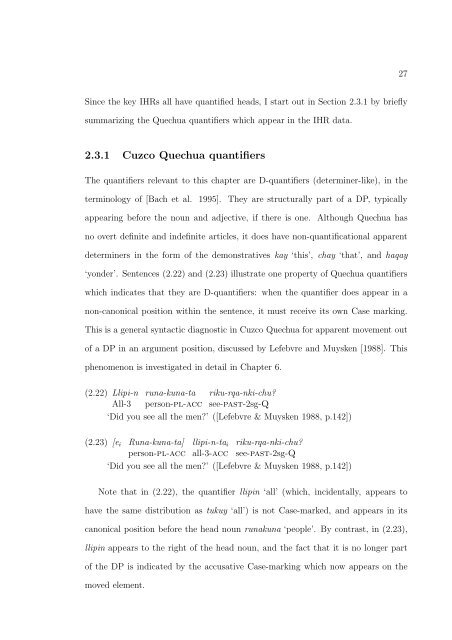the syntax and semantics of relativization and quantification
the syntax and semantics of relativization and quantification
the syntax and semantics of relativization and quantification
Create successful ePaper yourself
Turn your PDF publications into a flip-book with our unique Google optimized e-Paper software.
27<br />
Since <strong>the</strong> key IHRs all have quantified heads, I start out in Section 2.3.1 by briefly<br />
summarizing <strong>the</strong> Quechua quantifiers which appear in <strong>the</strong> IHR data.<br />
2.3.1 Cuzco Quechua quantifiers<br />
The quantifiers relevant to this chapter are D-quantifiers (determiner-like), in <strong>the</strong><br />
terminology <strong>of</strong> [Bach et al. 1995]. They are structurally part <strong>of</strong> a DP, typically<br />
appearing before <strong>the</strong> noun <strong>and</strong> adjective, if <strong>the</strong>re is one. Although Quechua has<br />
no overt definite <strong>and</strong> indefinite articles, it does have non-<strong>quantification</strong>al apparent<br />
determiners in <strong>the</strong> form <strong>of</strong> <strong>the</strong> demonstratives kay ‘this’, chay ‘that’, <strong>and</strong> haqay<br />
‘yonder’. Sentences (2.22) <strong>and</strong> (2.23) illustrate one property <strong>of</strong> Quechua quantifiers<br />
which indicates that <strong>the</strong>y are D-quantifiers: when <strong>the</strong> quantifier does appear in a<br />
non-canonical position within <strong>the</strong> sentence, it must receive its own Case marking.<br />
This is a general syntactic diagnostic in Cuzco Quechua for apparent movement out<br />
<strong>of</strong> a DP in an argument position, discussed by Lefebvre <strong>and</strong> Muysken [1988]. This<br />
phenomenon is investigated in detail in Chapter 6.<br />
(2.22) Llipi-n<br />
All-3<br />
runa-kuna-ta<br />
person-pl-acc<br />
riku-rqa-nki-chu?<br />
see-past-2sg-Q<br />
‘Did you see all <strong>the</strong> men?’ ([Lefebvre & Muysken 1988, p.142])<br />
(2.23) [e i Runa-kuna-ta]<br />
person-pl-acc<br />
llipi-n-ta i<br />
all-3-acc<br />
riku-rqa-nki-chu?<br />
see-past-2sg-Q<br />
‘Did you see all <strong>the</strong> men?’ ([Lefebvre & Muysken 1988, p.142])<br />
Note that in (2.22), <strong>the</strong> quantifier llipin ‘all’ (which, incidentally, appears to<br />
have <strong>the</strong> same distribution as tukuy ‘all’) is not Case-marked, <strong>and</strong> appears in its<br />
canonical position before <strong>the</strong> head noun runakuna ‘people’. By contrast, in (2.23),<br />
llipin appears to <strong>the</strong> right <strong>of</strong> <strong>the</strong> head noun, <strong>and</strong> <strong>the</strong> fact that it is no longer part<br />
<strong>of</strong> <strong>the</strong> DP is indicated by <strong>the</strong> accusative Case-marking which now appears on <strong>the</strong><br />
moved element.
















